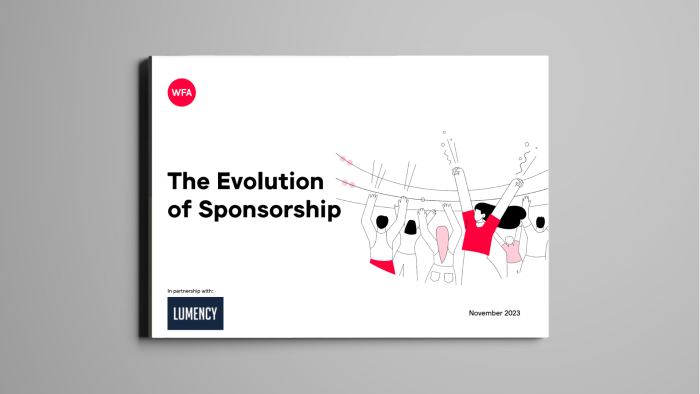Brands missing social opportunities of sponsorship
Sponsorship to drive sustainability and social equity should be used more by multinational brands, a new WFA report says.
Share this post

Please note that this report is WFA member content only. If you would like to know more about WFA membership, please get in touch with membership@wfanet.org.
Brands are also underestimating the importance of monitoring and evaluating the impact of sponsorship, says the WFA Evolution of Sponsorship report, produced in partnership with Lumency.
“Sponsorship offers brands a unique chance to connect with consumers while they’re doing what they like the most, perhaps watching a football game or going to a music festival. It’s a great opportunity for brands to pave the way for a better world, live up to their purpose, and lead positive change rebalancing inequalities,” said Laura Forcetti, Director of Global Marketing Sourcing at WFA.
But almost half (42%) of brands surveyed are not yet using their sponsorships to advance and demonstrate their sustainability and/or social equity agendas. A further 9% don’t know what if any use is being made of sponsorship to drive values. Just 49% say they are using sponsorship to promote sustainability or social equity.
As well as missing the opportunity to be a force for good, this gap between values and engagement matters because, as traditional consumer connections splinter, it has grown more challenging for brands to reach in particular target audiences among the younger Generations Z and Alpha. Sponsorship is an opportunity to establish an emotional connection with audiences by engaging through their passions and enhancing their experiences.
The Evolution of Sponsorship report was designed to provide WFA members with a better understanding of the current state of sponsorship, the challenges brands face, and where sponsorship is heading. It covered 34 multinational companies, with total global advertising spend of USD $51.3 billion.
Unmonitored Outcomes
Global sporship spending by brands was USD $97.4B in 2022 and is projected to grow to USD $189.5B by 2030, according to the Global Sports Sponsorship Market, Research and Markets, April 2023. This is a compounded annual growth rate of 8.7% and the WFA study found that sponsorship accounts for, on average 11% of a brand’s marketing budget, second only to media spend for many brands.
But in 2023, just 5% of brands say they feel "very confident" that the investments in their sponsorship portfolio are addressing the right audience, with the right assets and for the right spend.
“Despite this uncertainty around the return on investment (ROI) of sponsorship spend, the research also shows that for many brands, sponsorship activity remains relatively unmanaged and unmeasured,” said Ian Malcolm, Lumency President and CEO.
Most brands said measuring ROI of their sponsorship is their most significant challenge related to sponsorship activity, with a majority putting it in the top three. However, brands are spending on average 1% or less of their sponsorship budget on post-evaluation/impact (ROI) measurement, with just over a fifth of brands spending nothing.
Many brands were also found to measure outputs rather than outcomes. Outputs include things like the number of attendees at an event or the number of entrants to a sweepstake. Outcomes are the effect sponsorship has on commercial and brand objectives, such as improved consumer awareness, familiarity and opinion.
"Outputs lead to outcomes, but if a brand stops the measuring with outputs, they’ll fail to understand the real impact of a sponsorship on their brand and the business," said Ian Malcolm.
While 38% of brands are working on developing a model or framework to determine the commercial value of the rights and entitlements they secure with their sponsorships, just 31% already use such a framework and an additional 31% have no plans to develop one.
Brands are also found often to overlook the power of activation, when it comes to delivering on goals and connecting with customers. This is another missed opportunity.
Across the brands surveyed, 2 in 5 (43%) say they do not know what they are spending on the activation of sponsorships. Almost the same proportion (39%) are spending less on activation than on rights fees.
Activation includes spending on campaigns, events, experiences and other initiatives linked to a sponsorship deal designed to build brand loyalty and influence consumer behaviour.
Greater Collaborations
As well as social and efficacy opportunities, brands today risk missing an opportunity to build on procurement team expertise to improve sponsorship spend. Of the brands that have procurement involvement in sponsorship spend, 82% say this is a mid to-top sourcing priority for them.
“The report shows that many departments are involved in sponsorship initiatives, from legal teams to compliance departments, and even reputational risk fora,” said Laura Forcetti. “Marketing procurement is uniquely positioned at the intersection of external capabilities and internal business needs to drive effectiveness in sponsorship, bringing better stakeholder alignment, spend commitments, and even fulfilment.”
Procurement teams – who have a view across the total like no other function, can bring structure and add value to the organisation’s sponsorship activity, well beyond negotiation of rights and contracting. Half of survey respondents either said they already have a dedicated procurement resource or team for sponsorship (47% or are developing one (3%).




